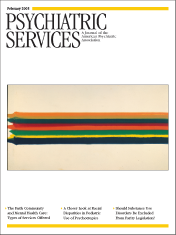Effect of Medicaid Eligibility Category on Racial Disparities in the Use of Psychotropic Medications Among Youths
Abstract
OBJECTIVE: This study sought to determine the degree to which Medicaid eligibility categories modify disparities between black and white youths in the prevalence of psychotropic medication. METHODS: Computerized claims for 189,486 youths aged two to 19 years who were continuously enrolled in a mid-Atlantic state Medicaid program for the year 2000 were analyzed to determine population-based annual prevalence of psychotropic medication by race or ethnicity and by whether the youths were eligible for Medicaid for reasons of family income, disability, or foster care placement. Logistic regression was used to assess the interaction of eligibility category and race. RESULTS: The mean annual prevalence of psychotropic medication for the population was 9.9 percent. The prevalence was 2.17 times higher for white youths than for black youths (16.5 percent compared with 7.6 percent). However, within eligibility categories, the white-to-black disparity was 3.8 among youths who were eligible for Medicaid because their family income was below the federal poverty level and 3.2 for youths enrolled in the State Children's Health Insurance Program. CONCLUSIONS: Medicaid eligibility categories had a profound impact on the racial disparity associated with the prevalence of psychotropic medications for youths. Eligibility category should be taken into account when ascertaining the role of access, undertreatment, and culture in disparities in mental health treatment.



